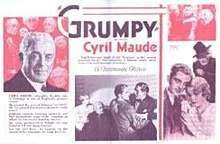Plot
The titular character is a temperamental but lovable retired London barrister now living in the country with his granddaughter Virginia. Ernest Heron, Virginia's beau, returns from South Africa with a valuable diamond, and that night he is attacked and the gem is stolen. The only clue to the perpetrator's identity is a camellia Ernest is found clutching in his hand.
Suspicion falls upon Chamberlin Jarvis, an acquaintance of Virginia who was a houseguest at the time, and Grumpy follows him when he returns to the city, where he tries to sell the diamond to Berci. Knowing Jarvis is a suspect, Berci turns him away, and the thief, frightened by a confrontation with Grumpy, eventually returns to the country, returns the jewel, and is arrested.

George Dewey Cukor was an American film director and producer. He mainly concentrated on comedies and literary adaptations. His career flourished at RKO when David O. Selznick, the studio's Head of Production, assigned Cukor to direct several of RKO's major films, including What Price Hollywood? (1932), A Bill of Divorcement (1932), Our Betters (1933), and Little Women (1933). When Selznick moved to Metro-Goldwyn-Mayer in 1933, Cukor followed and directed Dinner at Eight (1933) and David Copperfield (1935) for Selznick, and Romeo and Juliet (1936) and Camille (1936) for Irving Thalberg.
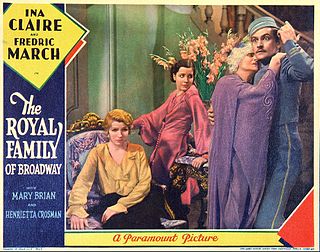
The Royal Family of Broadway is a 1930 American pre-Code comedy film directed by George Cukor and Cyril Gardner and released by Paramount Pictures. The screenplay was adapted by Herman J. Mankiewicz and Gertrude Purcell from the play The Royal Family by Edna Ferber and George S. Kaufman. It stars Ina Claire, Fredric March, Mary Brian, Henrietta Crosman, Arnold Korff, and Frank Conroy. It was shot at the Astoria Studios in New York.
The year 1949 in film involved some significant events.

Two Women is a 1960 war drama film directed by Vittorio De Sica from a screenplay he co-wrote with Cesare Zavattini, based on the 1957 novel of the same name by Alberto Moravia. The film stars Sophia Loren, Jean-Paul Belmondo, Eleonora Brown and Raf Vallone. It tells the story of a woman trying to protect her young daughter from the horrors of war. The story is fictional, but based on actual events of 1944 in Rome and rural Lazio, during the Marocchinate.

The Royal Family is a play written by George S. Kaufman and Edna Ferber. Its premiere on Broadway was at the Selwyn Theatre on 28 December 1927, where it ran for 345 performances to close in October 1928. It was included in Burns Mantle's The Best Plays of 1927–1928.

A Bill of Divorcement is a 1932 American pre-Code drama film directed by George Cukor and starring John Barrymore and Katharine Hepburn in her film debut. It is based on the 1921 British play of the same name, written by Clemence Dane as a reaction to a law passed in Britain in the early 1920s that allowed insanity as grounds for a woman to divorce her husband. It was the second screen adaptation of the play; the first was a 1922 British silent film also titled A Bill of Divorcement. The film was made again in 1940 by RKO Pictures.
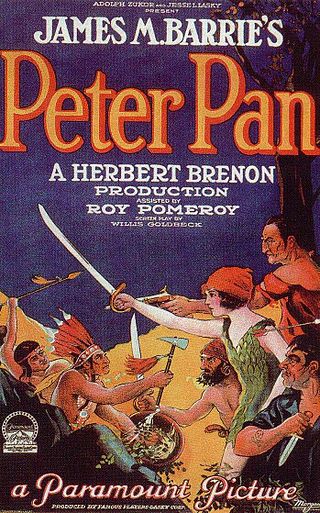
Peter Pan is a 1924 American silent adventure film released by Paramount Pictures, the first film adaptation of the 1904 play by J. M. Barrie. It was directed by Herbert Brenon and starred Betty Bronson as Peter Pan, Ernest Torrence as Captain Hook, Mary Brian as Wendy, Virginia Browne Faire as Tinker Bell, Esther Ralston as Mrs. Darling, and Anna May Wong as the Native American princess Tiger Lily. The film was seen by Walt Disney, and inspired him to create his company's 1953 animated adaptation.
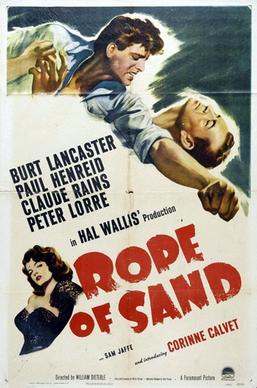
Rope of Sand is a 1949 American adventure-suspense film noir directed by William Dieterle, produced by Hal Wallis, and starring Burt Lancaster and three stars from Wallis's Casablanca – Paul Henreid, Claude Rains and Peter Lorre. The film introduces Corinne Calvet and features Sam Jaffe, John Bromfield, and Kenny Washington in supporting roles. The picture is set in South West Africa. Desert portions of the film were shot in Yuma, Arizona.
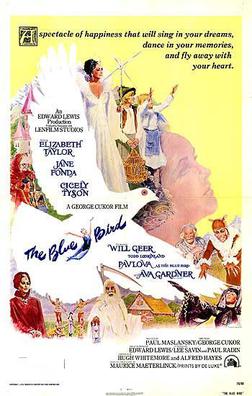
The Blue Bird is a 1976 American-Soviet children's fantasy film directed by George Cukor. The screenplay by Hugh Whitemore, Alfred Hayes, and Aleksei Kapler is based on the 1908 play L'Oiseau bleu by Maurice Maeterlinck. It was the fifth screen adaptation of the play, following two silent films, the studio's 1940 version starring Shirley Temple, and a 1970 animated feature. It was famous as one of the few cinematic co-productions between the United States and the Soviet Union during the Cold War. However unlike prior adaptations the film received little-to-no critical praise and was a flop at the box office.
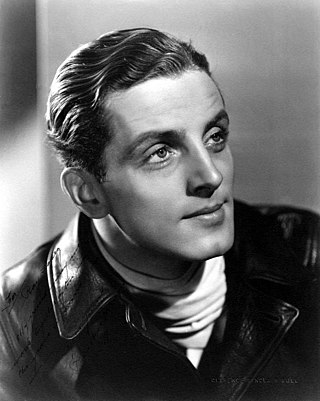
Phillips Raymond Holmes was an American actor. For his contributions to the film industry, he was posthumously given a star on the Hollywood Walk of Fame in 1960.

Visit to a Small Planet is a 1960 American black-and-white science fiction comedy film directed by Norman Taurog and starring Jerry Lewis, Joan Blackman, Earl Holliman, and Fred Clark. Distributed by Paramount Pictures, it was produced by Hal B. Wallis.
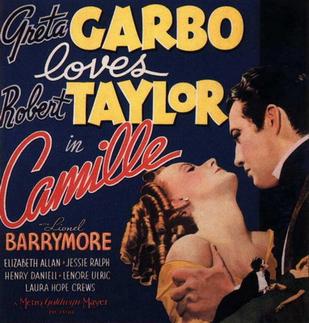
Camille is a 1936 American romantic drama film from Metro-Goldwyn-Mayer directed by George Cukor, and produced by Irving Thalberg and Bernard H. Hyman, from a screenplay by James Hilton, Zoë Akins, and Frances Marion. The picture is based on the 1848 novel and 1852 play La dame aux camélias by Alexandre Dumas, fils. The film stars Greta Garbo, Robert Taylor, Lionel Barrymore, Elizabeth Allan, Jessie Ralph, Henry Daniell, and Laura Hope Crews. It grossed $2,842,000.

Bhowani Junction is a 1956 British adventure drama film of the 1954 novel Bhowani Junction by John Masters. The film was directed by George Cukor and produced by Pandro S. Berman from a screenplay by Sonya Levien and Ivan Moffat.

Zaza is a 1939 American romantic drama film made by Paramount Pictures, and directed by George Cukor. The screenplay was written by Zoë Akins, based on the play Zaza. The music score is by Frederick Hollander. The film stars Claudette Colbert and Herbert Marshall.

Our Betters is a 1933 American pre-Code satirical comedy film directed by George Cukor and starring Constance Bennett, Anita Louise and Gilbert Roland. The screenplay by Jane Murfin and Harry Wagstaff Gribble is based on the 1917 play of the same title by Somerset Maugham. Tommy Atkins worked as assistant director, while the sets were designed by the art director Van Nest Polglase.

The Virtuous Sin is a 1930 American pre-Code comedy-drama film directed by George Cukor and Louis J. Gasnier and starring Walter Huston, Kay Francis, and Kenneth MacKenna. The screenplay by Martin Brown and Louise Long is based on the 1928 play The General by Lajos Zilahy. A separate 1931 German-language version The Night of Decision was shot at Paramount's Joinville Studios in Paris.
The Man Outside is a 1933 British crime film directed by George A. Cooper and starring Henry Kendall, Gillian Lind and Joan Gardner. It was shot at Twickenham Studios in London and features sets designed by the art director James A. Carter. Made as a quota quickie, it was distributed by RKO Pictures. It is unrelated to the play The Man Outside, which was not written until 1946.
Cyril Gardner was a French-born American actor, film director, editor and screenwriter.

Grumpy is a 1923 American silent comedy drama film distributed by Paramount Pictures. It is based on a 1913 Broadway play Grumpy by Horace Hodges and Thomas Wigney Percyval and starred English actor Cyril Maude. The director of this film is William C. deMille, brother of Cecil, and the star is Theodore Roberts. This film was remade by Paramount as an early sound film for Cyril Maude reprising his Broadway role. This silent version was thought to be long lost, but a copy has been discovered in the Gosfilmofond Archive in Moscow, Russia.

A Wizard's Tale is a 2018 computer-animated adventure comedy film based on the DePatie–Freleng animated series, Here Comes the Grump, which originally ran from 1969 to 1970 on NBC.
